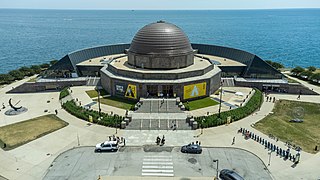
The Adler Planetarium is a public museum in Chicago, Illinois, dedicated to astronomy and astrophysics. It was founded in 1930 by local businessman Max Adler. Located on the northeastern tip of Northerly Island on Lake Michigan, the Adler Planetarium was the first planetarium in the United States. It is part of Chicago's Museum Campus, which includes the John G. Shedd Aquarium and The Field Museum. The Planetarium's mission is to inspire exploration and understanding of the universe.

Stardome Observatory & Planetarium is a public astronomical observatory and planetarium situated in Maungakiekie/One Tree Hill Domain in Auckland, New Zealand.

Griffith Observatory is an observatory in Los Angeles, California, on the south-facing slope of Mount Hollywood in Griffith Park. It commands a view of the Los Angeles Basin including Downtown Los Angeles to the southeast, Hollywood to the south, and the Pacific Ocean to the southwest. The observatory is a popular tourist attraction with a close view of the Hollywood Sign and an extensive array of space and science-related displays. It is named after its benefactor, Griffith J. Griffith. Admission has been free since the observatory's opening in 1935, in accordance with the benefactor's will.

Liberty Science Center is an interactive science museum and learning center located in Liberty State Park in Jersey City, New Jersey, United States. At its opening, it was the largest such planetarium in the Western Hemisphere and the world's fourth largest.

The Carnegie Science Center, soon to be The Daniel G. and Carole L. Kamin Science Center, is one of the four Carnegie Museums of Pittsburgh, Pennsylvania. It is located in the Chateau neighborhood. It is located across the street from Acrisure Stadium.

The Manitoba Museum, previously the Manitoba Museum of Man and Nature, is a human and natural history museum in Winnipeg, Manitoba, as well as the province's largest, not-for-profit centre for heritage and science education.
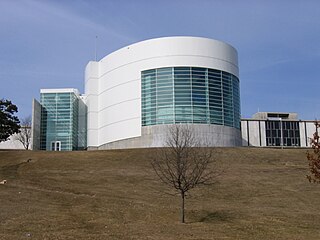
The Putnam Museum and Science Center, originally Davenport Academy of Natural Sciences, is a museum of history and natural science with an interactive science center in Davenport, Iowa, United States. The museum was founded in 1867, and was one of the first museums west of the Mississippi River. It houses around 250,000 historical artifacts and specimens in its collections. It is located at 1717 West 12th Street, at the corner of Division and West 12th Street on "museum hill," near Fejervary Park. It is an affiliate of the Smithsonian Institution.

The Denver Museum of Nature & Science is a municipal natural history and science museum in Denver, Colorado. It is a resource for informal science education in the Rocky Mountain region. A variety of exhibitions, programs, and activities help museum visitors learn about the natural history of Colorado, Earth, and the universe. The 716,000-square-foot (66,519 m2) building houses more than one million objects in its collections including natural history and anthropological materials, as well as archival and library resources.
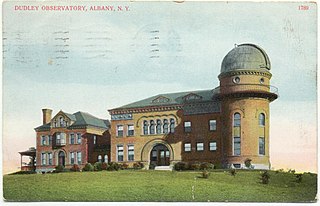
Dudley Observatory is an astronomical education non-profit located since 2019 in Loudonville, New York and is the oldest non-academic institution of astronomical research in America. It was formerly located in Albany, New York (1856-1973) and Schenectady (1973-2019) and was once a working observatory.
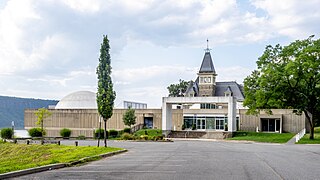
The Hudson River Museum, located in Trevor Park in Yonkers, New York, is the largest museum in Westchester County, and features the only public planetarium in the county. While often considered an art museum due to its extensive collection of Hudson River School paintings, the museum also presents exhibits on the history, science and heritage of the region.

The McLaughlin Planetarium is a former working planetarium whose building occupies a space immediately to the south of the Royal Ontario Museum in Toronto, at 100 Queen's Park. Founded by a grant from philanthropist Colonel R. Samuel McLaughlin, the facility was opened to the public on October 26, 1968. It had, for its time, a state-of-the-art electro-mechanical Zeiss planetarium projector that was used to project regular themed shows about the stars, planets, and cosmology for visitors. By the 1980s the planetarium's sound-system and domed ceiling were used to display dazzling music-themed laser-light shows. The lower levels of the planetarium contained a gallery called the "Astrocentre" that featured space-related exhibits, related artifacts on the history of astronomy and was also home of the world's first commercial Stellarium
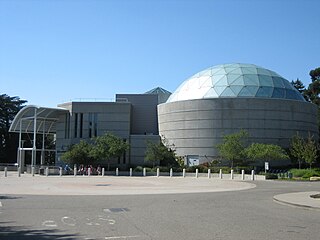
Chabot Space and Science Center, located in Oakland, California, is a center for learning in Earth and space science, which features interactive exhibits, planetariums, a large screen theater, hands-on activities, and three powerful telescopes.

The Rochester Museum & Science Center (RMSC) is a museum in Rochester, New York, dedicated to community education in science, technology and local history. The museum also operates the Strasenburgh Planetarium, located next to the museum, and the Cumming Nature Center, a 900-acre (3.6 km2) nature preserve near Naples, New York. The museum resides at 657 East Ave. and has a collection of 1.2 million artifacts.
Chauncey Guy Suits was a distinguished director of the General Electric (GE) Research Laboratory, and a founding member of the National Academy of Engineering.

The Empire State Aerosciences Museum is a non-profit museum which strives to "educate, entertain and excite with experiences in air and space". Established in 1984 and chartered by the New York State Department of Education, the museum is located on 27 acres (110,000 m2) of land on the western perimeter of the Schenectady County Airport in Glenville, New York, United States.

The McAuliffe-Shepard Discovery Center is a science museum located in Concord, New Hampshire, United States, next door to the NHTI campus. The museum is dedicated to Christa McAuliffe, the Concord High School social studies teacher selected by NASA out of over 11,000 applicants to be the first teacher in space, and Alan Shepard, the Derry, New Hampshire, native and Navy test pilot who became the first American in space and one of only twelve human beings to walk on the Moon. The Discovery Center's stated mission is to inspire new generations to explore space, through engaging, artful, and entertaining activities focused on astronomy, aviation, Earth and space science.

The Fairbanks Museum & Planetarium is a combination natural science museum, history museum, and planetarium located in St. Johnsbury, Vermont. It was founded in 1890 by businessman, politician, naturalist, and collector Franklin Fairbanks. The museum and its buildings are on the U.S. National Register of Historic Places.

The National Planetarium, also known as the National Museum Planetarium, was a planetarium owned and operated by the National Museum of the Philippines in Manila. It was a 16-meter (52 ft) dome located in Rizal Park between the Japanese Garden and Chinese Garden on Padre Burgos Avenue in the central district of Ermita. It opened on October 8, 1975.
Clark C. Wemple was an American politician who served in the New York State Assembly from 1966 to 1982. He was a descendant of one of the original founders of the city of Schenectady. One of his sons is the journalist Erik Wemple.

















